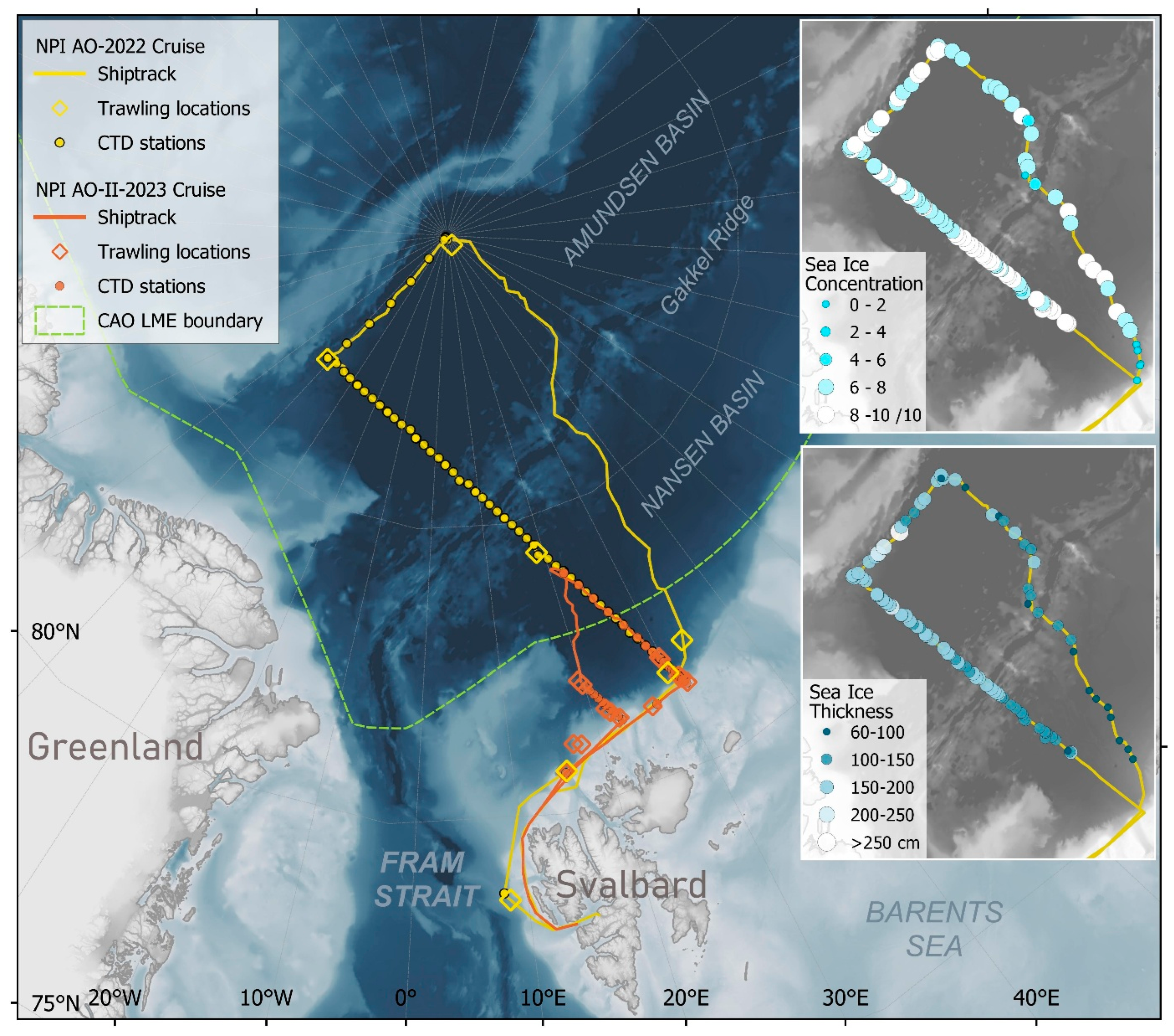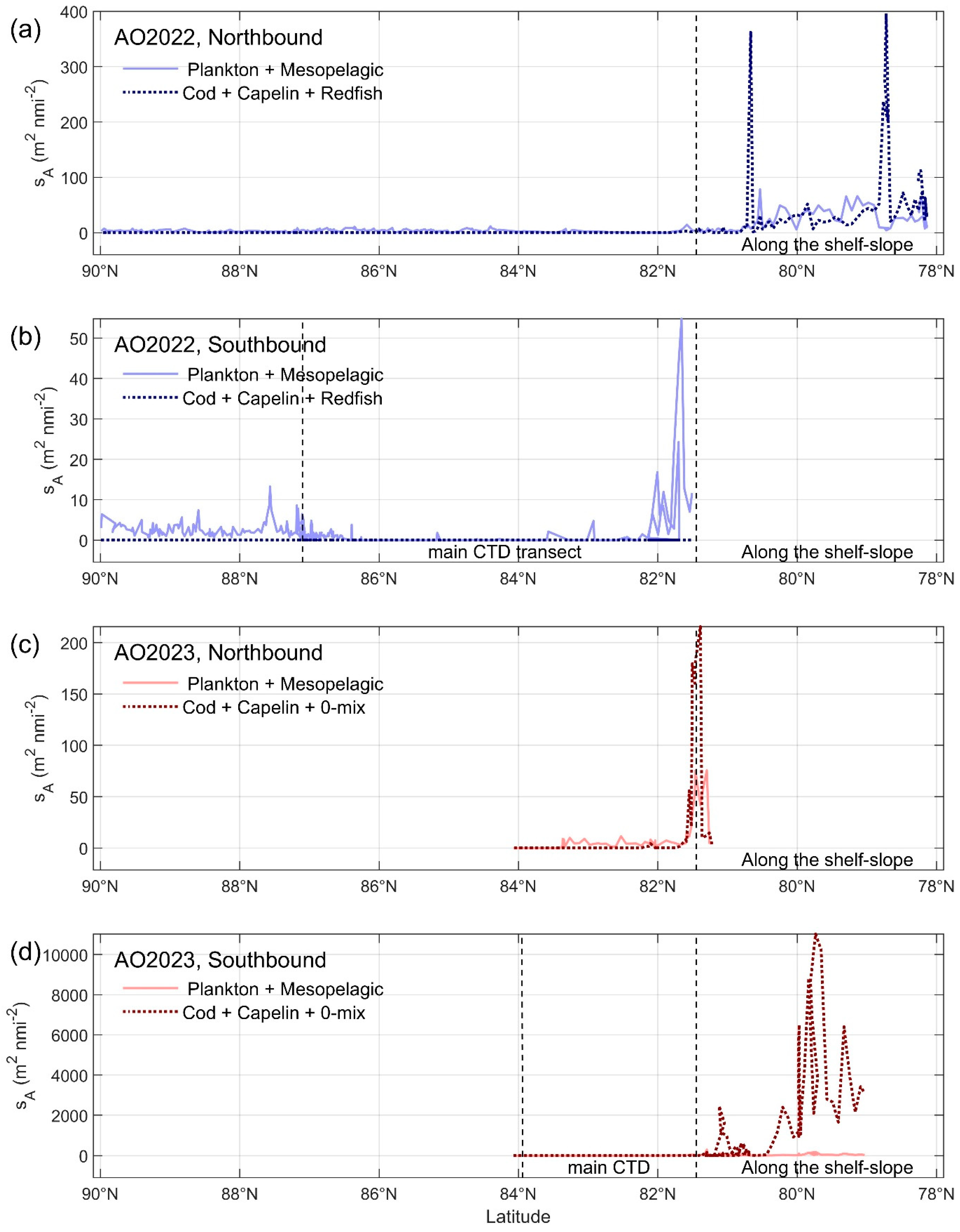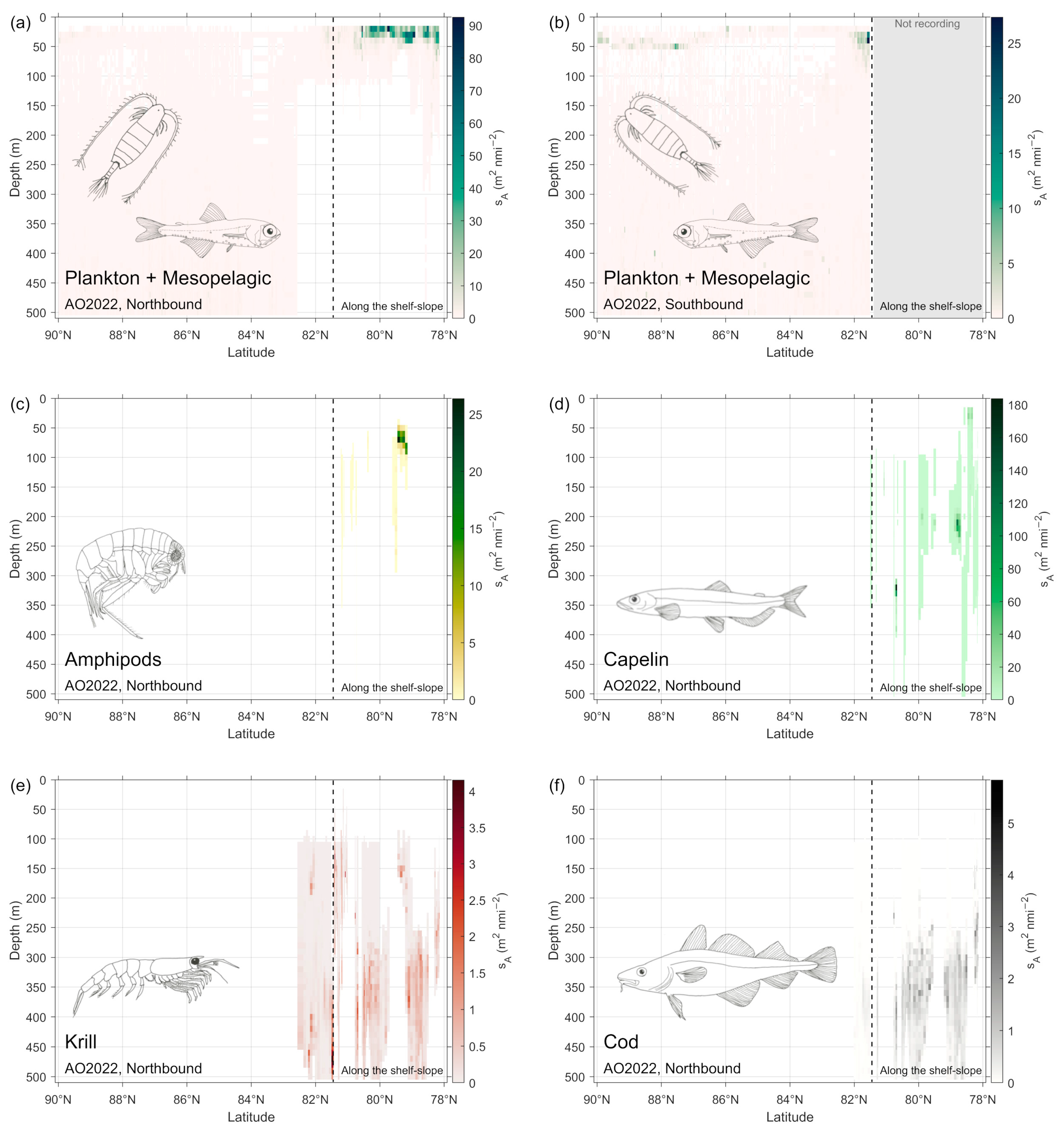Quantifying Area Back Scatter of Marine Organisms in the Arctic Ocean by Machine Learning-Based Post-Processing of Volume Back Scatter
Abstract
1. Introduction
2. Materials and Methods
2.1. Post-Processing—General Protocol and Principles
2.2. Post-Processing of Echosounder Recordings from the Arctic Ocean
3. Results
4. Discussion
Author Contributions
Funding
Institutional Review Board Statement
Informed Consent Statement
Data Availability Statement
Acknowledgments
Conflicts of Interest
Abbreviations
| AO2022 | Arctic Ocean cruise 2022 |
| AO2023 | Arctic Ocean cruise 2023 |
| CAO | Central Arctic Ocean |
| IMR | Institute of Marine Research |
| KPH | R/V Kronprins Haakon |
| NASC | nautical area back-scattering strength, sA with the unit m2/(nautical mile)2 = m2 nmi−2 [34] |
| NPI | The Norwegian Polar Institute |
References
- Foote, K.G. Acoustic scattering by marine organisms. In Encyclopedia of Ocean Sciences, 3rd ed.; Cochran, K., Bokuniewics, H., Yager, P.L., Eds.; Academic Press: Cambridge, MA, USA, 2019; pp. 260–273. [Google Scholar] [CrossRef]
- Holliday, D.V.; Pieper, R.E.; Kleppel, G.S. Determination of zooplankton size and distribution with multifrequency acoustic technology. J. Cons. 1989, 46, 52–61. [Google Scholar] [CrossRef]
- Misund, O.A. Underwater acoustics in marine fisheries and fisheries research. Rev. Fish Biol. Fish. 1997, 7, 1–34. [Google Scholar] [CrossRef]
- Simmonds, E.J.; MacLennan, D.N. Fish and Fisheries Series. In Fisheries Acoustics: Theory and Practice, 2nd ed.; Blackwell Publishing: Oxford, UK, 2005; p. 456. [Google Scholar]
- Dragesund, O.; Olsen, S. On the possibility of estimating year-class strength by measuring echo-abundance of O-group fish. FiskDir. Skr. Ser. Havunders. 1965, 13, 48–62. [Google Scholar]
- Foote, K.G. Fish target strengths for use in echo integrator surveys. J. Acoust. Soc. Am. 1987, 82, 981–987. [Google Scholar] [CrossRef]
- Blindheim, J.; Eide, P.K.; Knudsen, H.P.; Vestnes, G.A. ship-born data logging and processing system for Acoustic Fish Surveys. Fish. Res. 1982, 1, 141–153. [Google Scholar] [CrossRef]
- Knudsen, H.P. Long-term evaluation of scientific-echosounder performance. ICES J. Mar. Sci. 2009, 66, 1335–1340. [Google Scholar] [CrossRef]
- Mitson, R.B.; Knudsen, H.P. Causes and effects of underwater noise on fish abundance estimation. Aquat. Liv. Res. 2003, 16, 255–263. [Google Scholar] [CrossRef]
- Knudsen, H.P. The Bergen Echo integrator—An introduction. J. Cons. 1990, 47, 167–174. [Google Scholar] [CrossRef]
- Foote, K.G.; Knudsen, H.P.; Korneliussen, R.J.; Nordbø, P.E.; Røang, K. Postprocessing system for echosounder data. J. Acoust. Soc. Am. 1991, 90, 37–47. [Google Scholar] [CrossRef]
- Myriax. Echoview@. Hobart, TAS, 2024. Available online: http://echoview.com (accessed on 28 February 2025).
- Korneliussen, R.J. The Bergen echo integrator post-processing system, with focus on recent improvements. Fish. Res. 2004, 68, 159–169. [Google Scholar] [CrossRef]
- Korneliussen, R.J.; Heggelund, Y.; Macaulay, G.; Johnsen, E. Acoustic identification of marine species using a feature library. Meth. Oceanogr. 2016, 17, 187–205. [Google Scholar] [CrossRef]
- Mathisen, S. (Ed.) Kronprins Haakon; Orkana: Oslo, Norway, 2019; pp. 1–190. (In Norwegian) [Google Scholar]
- Andersen, L.N.; Chu, D.Z.; Handegard, N.O.; Heimvoll, H.; Korneliussen, R.; MacCaulay, G.J.; Ona, E.; Patel, R.; Pedersen, R. Quantitative processing of broadband data as implemented in a scientific splitbeam echosounder. Meth. Ecol. Evol. 2024, 15, 317–328. [Google Scholar] [CrossRef]
- Dodd, P.; Nikolopoulos, A.; Buckley, S.; Campbell, K.; Divine, D.; Eggen, V.; Fransson, A.; Gonçalves-Araujo, R.; Granskog, M.; Hop, H.; et al. Arctic Ocean 2022 Cruise Report; Norsk Polarinstitutt: Tromsø, Norway, 2022; 98p, Available online: https://hdl.handle.net/11250/3013026 (accessed on 28 February 2025).
- Ingvaldsen, R.B.; Eriksen, E.; Gjøsæter, H.; Engås, A.; Schuppe, B.K.; Assmann, K.M.; Cannaby, H.; Dalpadado, P.; Bluhm, B.A. Under-ice observations by trawls and multi-frequency acoustics in the Central Arctic Ocean reveals abundance and composition of pelagic fauna. Sci. Rep. 2023, 13, 1000. [Google Scholar] [CrossRef] [PubMed]
- Hop, H.; Wold, A.; Misund, O. (Eds.) NPI Arctic Ocean Cruise II; Norwegian Polar Institute: Tromsø, Norway, 2023; 98p. [Google Scholar]
- Midttun, L.; Nakken, O. On acoustic identification, sizing and abundance estimation of fish. FiskDir. Skr. Ser. Havunders. 1971, 16, 36–48. [Google Scholar]
- Korsbrekke, K.; Misund, O.A. On subjectivity in the judging of acoustic records: Comparison of degree of homogeneity inn allocation of echo values by different teams. Int. Counc. Explor. Sea 1993. [Google Scholar]
- Fall, J.; Gjøsæter, H.; Tvete, I.F.; Aldrin, M. Classification of acoustic survey data: A comparison between seven teams of experts. Fish. Res. 2024, 274, 107005. [Google Scholar] [CrossRef]
- Godø, O.R.; Valdemarsen, J.W.; Engås, A. Comparison of efficiency of standard and experimental juvenile gadoid sampling trawls. ICES Mar. Sci. Symp. 1993, 196, 196–201. [Google Scholar]
- Stanton, T.K.; Wiebe, P.H.; Chu, D.; Goodman, L. Acoustic characterization and discrimination of marine zooplankton and turbulence. ICES J. Mar. Sci. 1994, 51, 469–479. [Google Scholar] [CrossRef]
- Stanton, T.K.; Wiebe, P.H.; Chu, D.; Benfield, M.C.; Scanlon, L.; Martin, L.; Eastwood, R.L. On acoustic estimates of zooplankton biomass. ICES J. Mar. Sci. 1994, 51, 505–512. [Google Scholar] [CrossRef]
- Demer, D.A.; Conti, S.G. Validation of the stochastic distorted wave Born approximation model with broad bandwidth total target strength measurements of Antarctic krill. ICES J. Mar. Sci. 2003, 60, 625–635. [Google Scholar] [CrossRef]
- Sarr, J.M.A.; Brochier, T.; Brehmer, P.; Perrot, Y.; Bah, A.; Sarré, A.; Jeyid, M.A.; Sidibeh, M.; Ayoubi, S.E. Complex data labeling with deep learning methods: Lessons from fisheries acoustics. ISA Trans. 2021, 109, 113–125. [Google Scholar] [CrossRef]
- Malde, K.; Handegard, N.O.; Eikvil, L.; Salberg, A.-B. Machine intelligence and the data-driven future of marine science. ICES J. Mar. Sci. 2020, 77, 1274–1285. [Google Scholar] [CrossRef]
- Rubbens, P.; Brodie, S.; Cordier, T.; Destro Barcellos, D.; Devos, P.; Fernandes-Salvador, J.A.; Fincham, J.I.; Gomes, A.; Handegard, N.O.; Howell, K. Machine learning in marine ecology: An overview of techniques and applications. ICES J. Mar. Sci. 2023, 80, 1829–1853. [Google Scholar] [CrossRef]
- Brautaset, O.; Waldeland, A.U.; Johnsen, E.; Malde, K.; Eikvil, L.; Salberg, A.B.; Handegard, N.O. Acoustic classification in multifrequency echosounder data using deep convolutional neural networks. ICES J. Mar. Sci. 2020, 77, 1391–1400. [Google Scholar] [CrossRef]
- Pala, A.; Oleynik, A.; Utseth, I.; Handegard, N.O. Addressing class imbalance in deep learning for acoustic target classification. ICES J. Mar. Sci. 2023, 80, 2530–2544. [Google Scholar] [CrossRef]
- Pala, A.; Oleynik, A.; Malde, K.; Handegard, N.O. Self-supervised feature learning for acoustic data analysis. Ecol. Inform. 2024, 84, 102878. [Google Scholar] [CrossRef]
- Misund, O.A. Why should scientists lead? To underpin policy on marine and polar ecosystems. ICES J. Mar. Sci. 2024, 81, 823–832. [Google Scholar]
- MacLennan, D.N.; Fernandes, P.G.; Dalen, J. A Consistent approach to definitions and symbols in fisheries acoustics. ICES J. Mar. Sci. 2002, 59, 365–369. [Google Scholar] [CrossRef]





Disclaimer/Publisher’s Note: The statements, opinions and data contained in all publications are solely those of the individual author(s) and contributor(s) and not of MDPI and/or the editor(s). MDPI and/or the editor(s) disclaim responsibility for any injury to people or property resulting from any ideas, methods, instructions or products referred to in the content. |
© 2025 by the authors. Licensee MDPI, Basel, Switzerland. This article is an open access article distributed under the terms and conditions of the Creative Commons Attribution (CC BY) license (https://creativecommons.org/licenses/by/4.0/).
Share and Cite
Misund, O.A.; Nikolopoulos, A.; Stürzinger, V.; Hop, H.; Dodd, P.; Korneliussen, R.J. Quantifying Area Back Scatter of Marine Organisms in the Arctic Ocean by Machine Learning-Based Post-Processing of Volume Back Scatter. Sensors 2025, 25, 3121. https://doi.org/10.3390/s25103121
Misund OA, Nikolopoulos A, Stürzinger V, Hop H, Dodd P, Korneliussen RJ. Quantifying Area Back Scatter of Marine Organisms in the Arctic Ocean by Machine Learning-Based Post-Processing of Volume Back Scatter. Sensors. 2025; 25(10):3121. https://doi.org/10.3390/s25103121
Chicago/Turabian StyleMisund, Ole Arve, Anna Nikolopoulos, Vegard Stürzinger, Haakon Hop, Paul Dodd, and Rolf J. Korneliussen. 2025. "Quantifying Area Back Scatter of Marine Organisms in the Arctic Ocean by Machine Learning-Based Post-Processing of Volume Back Scatter" Sensors 25, no. 10: 3121. https://doi.org/10.3390/s25103121
APA StyleMisund, O. A., Nikolopoulos, A., Stürzinger, V., Hop, H., Dodd, P., & Korneliussen, R. J. (2025). Quantifying Area Back Scatter of Marine Organisms in the Arctic Ocean by Machine Learning-Based Post-Processing of Volume Back Scatter. Sensors, 25(10), 3121. https://doi.org/10.3390/s25103121








